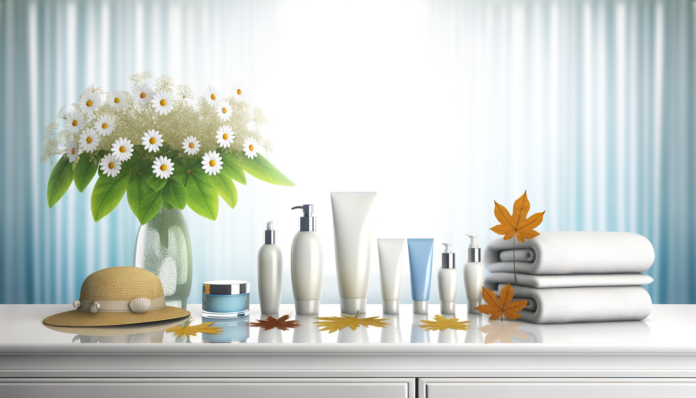Introduction
The Importance of Seasonal Skincare
Our skin is a dynamic organ that responds to environmental changes, making it essential to adapt our skincare routines with the seasons. Each season brings its own set of challenges, from the harsh, dry winds of winter to the intense sun and humidity of summer. Neglecting to adjust your skincare routine can lead to a variety of issues such as dryness, breakouts, and irritation. By tailoring your skincare regimen to the specific needs of each season, you can maintain a healthy, glowing complexion year-round.
How Weather Changes Affect Your Skin
Weather changes can have a significant impact on your skin. Here’s a brief overview of how different seasons affect your skin:
- Winter: Cold air and harsh winds can strip moisture from your skin, leading to dryness and irritation. Indoor heating further depletes moisture, resulting in flaky or dull skin.
- Spring: As temperatures start to warm up, your skin may produce more oil. Pollen in the air can also trigger sensitivity, leading to breakouts or rashes.
- Summer: High humidity combined with scorching heat can lead to excessive sweating, clogged pores, and breakouts. Sun exposure becomes a significant concern, requiring effective sun protection.
- Fall: As temperatures cool and humidity levels drop, your skin may begin to feel tight or dry, signaling a need for more hydration and nourishment.
Understanding these seasonal impacts allows you to make informed decisions about your skincare routine, ensuring that your skin remains balanced and resilient no matter the weather.
Overview of the Article
In this comprehensive guide, we will explore how to adapt your skincare routine to the changing seasons. The article is divided into the following sections:
- Spring Skincare Strategies: Tips for transitioning from winter to spring, dealing with allergies and sensitivities, and the importance of hydration and sun protection.
- Summer Skincare Strategies: Strategies for managing increased sun exposure, dealing with heat and humidity, and the importance of lightweight products and after-sun care.
- Fall Skincare Strategies: Guidance on transitioning from summer to fall, addressing dryness and sensitivity, and the benefits of richer moisturizers and exfoliation.
- Winter Skincare Strategies: Tips for combatting cold and wind, intensive moisturization, protecting against indoor heating, and special care for hands and lips.
- General Tips for All Seasons: Understanding your skin type, maintaining consistency and routine, the role of diet and hydration, and listening to your skin’s needs.
- Conclusion: A recap of seasonal strategies, encouragement to adapt and experiment, and final thoughts on maintaining healthy skin year-round.
By following the advice in this article, you can ensure that your skin remains healthy, radiant, and well-protected throughout the year.
Spring Skincare Strategies
Transitioning from Winter to Spring
As the cold, dry air of winter gives way to the warmer, more humid conditions of spring, your skin undergoes significant changes. During this transition, it’s essential to adjust your skincare routine to accommodate the new climate. Start by swapping out heavy, occlusive moisturizers for lighter, water-based options. This helps prevent clogged pores as your skin begins to produce more oil. Additionally, consider incorporating a gentle exfoliant to slough off the dead skin cells accumulated over the winter months. This will reveal a fresher, more radiant complexion.
Dealing with Allergies and Sensitivities
Spring is notorious for triggering allergies, which can lead to skin sensitivities, redness, and irritation. To combat these issues, opt for skincare products that contain soothing ingredients like chamomile, aloe vera, and calendula. These ingredients help calm inflammation and reduce redness. It’s also wise to perform a patch test when introducing new products to ensure they won’t exacerbate your allergies. If you suffer from severe allergies, consult a dermatologist for personalized advice.
Hydration and Light Moisturizers
With the increase in temperature and humidity, your skin’s hydration needs will change. While it’s still crucial to keep your skin hydrated, you can switch to lighter moisturizers that won’t feel heavy or greasy. Look for products that are non-comedogenic and contain hydrating ingredients like hyaluronic acid and glycerin. These ingredients attract moisture to the skin without clogging pores. Additionally, incorporating a hydrating serum into your routine can provide an extra layer of moisture, ensuring your skin remains plump and dewy.
Sun Protection
As the days grow longer and sunnier, sun protection becomes even more critical. UV rays can cause significant damage to your skin, leading to premature aging, hyperpigmentation, and an increased risk of skin cancer. Make it a habit to apply a broad-spectrum sunscreen with at least SPF 30 every morning, regardless of whether it’s sunny or cloudy. For added convenience, choose a lightweight, non-greasy formula that can be easily layered under makeup. Don’t forget to reapply every two hours if you’re spending extended periods outdoors, and consider wearing protective clothing and hats for additional defense against the sun.
Summer Skincare Strategies
Managing Increased Sun Exposure
Summer in Suffolk County brings intense sun exposure, making sun protection a top priority. **Broad-spectrum sunscreen** with an SPF of 50 or higher is essential. Apply it generously to all exposed skin, including often-missed areas like the ears, neck, and the back of your hands. Reapply every two hours, especially if you’re swimming or sweating. Additionally, wearing protective clothing, wide-brimmed hats, and UV-blocking sunglasses can further shield your skin from harmful UV rays.
Dealing with Heat and Humidity
The combination of heat and humidity can lead to excessive sweating, clogged pores, and breakouts. To combat this, switch to **gel-based cleansers and moisturizers**. These products are lightweight, absorb quickly, and won’t leave your skin feeling greasy. Incorporate a **toner** with ingredients like witch hazel to help control oil production and keep your pores clear. Also, consider using blotting papers throughout the day to manage excess oil and maintain a fresh complexion.
Lightweight Products and SPF
During the summer, your skin needs products that are both effective and breathable. Opt for **lightweight, oil-free moisturizers** that provide hydration without clogging pores. Look for formulations that include hyaluronic acid, which helps retain moisture without adding heaviness. **SPF is non-negotiable**; choose a lightweight, broad-spectrum sunscreen that won’t feel greasy. Many modern sunscreens offer additional skincare benefits, such as antioxidants, which can help protect against environmental damage.
After-Sun Care
Despite your best efforts, sometimes sun exposure is unavoidable. After-sun care is crucial for repairing and soothing your skin. Start with a **cool shower** to lower your skin temperature and remove any residual sunscreen or sweat. Follow up with a **soothing aloe vera gel** or a moisturizer containing ingredients like chamomile or calendula to calm any redness or irritation. For an extra boost, use a **hydrating sheet mask** to replenish lost moisture and restore your skin’s natural barrier. If you experience sunburn, apply a **calming lotion** with ingredients like aloe vera or hydrocortisone to reduce inflammation and promote healing.
By adapting your skincare routine to address the specific challenges of summer, you can maintain a healthy, glowing complexion even in the hottest months. Remember, consistency is key, and listening to your skin’s needs will help you navigate the season with ease.
Fall Skincare Strategies
Transitioning from Summer to Fall
As the vibrant days of summer fade into the crisp and colorful fall season, our skin often faces a challenging transition. The hot and humid summer weather tends to leave our skin oily and sun-kissed, but as the temperatures drop and the air becomes drier, our skincare routine needs to adapt to maintain healthy and hydrated skin.
Understanding the seasonal changes in skin is crucial. The shift from summer to autumn brings cooler temperatures and lower humidity levels, changing how your skin behaves. Here are some key changes to be aware of:
- Decreased Humidity: Humidity significantly drops in the fall, reducing moisture levels in the skin and making it feel dry and tight.
- Cooler Temperatures: Cold air can strip away natural oils from your skin, leading to flakiness and dryness.
- Indoor Heating: As we start heating our homes, the indoor air can become dry, further dehydrating our skin.
- Less Sun Exposure: With fewer sunlight hours, your skin may produce less Vitamin D, essential for skin health.
Addressing Dryness and Sensitivity
With the drop in humidity and temperature, your skin is more prone to dryness and sensitivity. To combat these changes, it’s crucial to adjust your skincare routine. Here are some effective strategies to ease your skin into the fall season:
- Switch to a Gentler Cleanser: Summer often calls for deep cleansing to remove sweat and sunscreen, but fall requires a gentler approach. Opt for a hydrating cleanser that cleans your skin without stripping away its natural oils.
- Exfoliate Regularly but Gently: Exfoliation will help remove dead skin cells, allowing better absorption of moisturizers. However, choose a gentle exfoliant during fall to avoid over-drying or irritating your skin. Aim to exfoliate 1-2 times a week.
- Increase Hydration: Your skin needs extra hydration with drier air. Switch to a thicker moisturizer that provides long-lasting hydration. Seek out ingredients like hyaluronic acid, glycerin, and ceramides that help retain moisture.
- Introduce Hydrating Serums: Incorporate a hydrating serum into your daily skincare routine to boost moisture levels. Serums with hyaluronic acid or vitamin E can penetrate deeper into your skin layers, providing intense hydration.
- Pay Attention to Your Lips and Hands: These areas are often neglected but can become extremely dry in the fall. Use a moisturizing hand cream and lip balm to keep them soft and hydrated.
Introducing Richer Moisturizers
As the air gets drier and the temperatures start to dip, your skin craves extra moisture and care. Begin reintroducing richer creams to your routine that offer a deeper level of hydration. Look for products that contain nourishing ingredients like shea butter, squalane, and ceramides. These ingredients help to lock in moisture and protect your skin from the harsh elements.
Exfoliation and Renewal
Fall is the perfect time to focus on skin renewal. After a long summer of sun exposure, your skin might be feeling a bit worn out. Incorporating products like retinol, peptides, and vitamin C into your routine can do wonders. They work together to smooth out rough texture, lighten dark spots, and give your skin a more even tone, helping you transition smoothly into the cooler months.
Regular exfoliation is also key. As the weather cools, the rate at which your skin naturally exfoliates can slow down, leading to a build-up of dead skin cells that can cause dullness and congestion. To maintain clear, radiant skin throughout autumn, it’s important to exfoliate regularly. However, the type of exfoliation should be tailored to your skin’s specific needs—gentler, hydrating exfoliants can prevent irritation during this more sensitive season. Look for exfoliants that include enzymes or mild acids, such as lactic or mandelic acid, which can effectively slough away dead skin cells without compromising your skin’s barrier. Aim for a weekly exfoliation routine to keep your complexion smooth, luminous, and ready to face the cooler weather with confidence.
Winter Skincare Strategies
Combatting Cold and Wind
Winter weather can be particularly harsh on your skin, with cold air and strong winds stripping away its natural moisture. To protect your skin from these elements, consider the following strategies:
- Layer Up: Wear scarves, hats, and gloves to physically shield your skin from the wind and cold.
- Barrier Creams: Use barrier creams that contain ingredients like ceramides and fatty acids to create a protective layer on your skin.
- Hydrating Masks: Incorporate hydrating masks into your routine to replenish lost moisture and soothe irritated skin.
Intensive Moisturization
Winter air is not only cold but also dry, which can lead to dehydrated, flaky skin. Intensive moisturization is key to maintaining a healthy complexion during these months.
- Rich Moisturizers: Switch to thicker, more occlusive moisturizers that lock in moisture. Look for ingredients like hyaluronic acid, glycerin, and shea butter.
- Night Creams: Use a rich night cream to provide your skin with extra hydration while you sleep.
- Humidifiers: Consider using a humidifier in your home to add moisture to the air, which can help keep your skin hydrated.
Protecting Against Indoor Heating
Indoor heating can be just as damaging to your skin as the cold outdoor air. It tends to dry out the air, which in turn dries out your skin.
- Hydrating Sprays: Keep a hydrating facial spray handy to mist your face throughout the day, providing instant moisture.
- Frequent Moisturization: Apply moisturizer more frequently, especially after washing your hands or face.
- Lower Thermostat: Try to keep your indoor heating at a moderate level to prevent excessive dryness.
Special Care for Hands and Lips
Your hands and lips are particularly vulnerable to winter’s harsh conditions and often require special attention.
- Hand Creams: Use a thick, nourishing hand cream multiple times a day, especially after washing your hands. Look for ingredients like urea and lanolin.
- Lip Balms: Apply a hydrating lip balm regularly to prevent chapping. Opt for balms that contain beeswax, shea butter, or coconut oil.
- Overnight Treatments: Consider using overnight treatments for both your hands and lips to provide deep hydration while you sleep.
By implementing these winter skincare strategies, you can effectively combat the harsh effects of cold weather, ensuring your skin remains healthy, hydrated, and protected throughout the season.
General Tips for All Seasons
Understanding Your Skin Type
Before you can effectively adapt your skincare routine to the changing seasons, it’s crucial to understand your skin type. Whether you have oily, dry, combination, or sensitive skin, knowing your skin type helps you choose the right products and treatments. For instance, oily skin may require lightweight, non-comedogenic products, while dry skin benefits from richer, more hydrating formulations. Take the time to assess your skin’s needs and adjust your routine accordingly.
Consistency and Routine
Consistency is key to maintaining healthy skin throughout the year. Establishing a daily skincare routine that includes cleansing, moisturizing, and sun protection is essential. Stick to this routine regardless of the season, but make adjustments as needed. For example, you might switch to a heavier moisturizer in the winter and a lighter one in the summer. Consistency helps your skin adapt to changes more smoothly and ensures long-term benefits.
Diet and Hydration
What you put into your body is just as important as what you apply to your skin. A balanced diet rich in vitamins, minerals, and antioxidants can significantly impact your skin’s health. Foods high in omega-3 fatty acids, such as salmon and flaxseeds, help maintain your skin’s barrier function. Additionally, staying hydrated is crucial. Drinking plenty of water helps keep your skin plump and hydrated, which is especially important during extreme weather conditions.
Listening to Your Skin
Your skin is constantly communicating with you, and it’s important to listen. Pay attention to how your skin reacts to different products and environmental changes. If you notice increased dryness, breakouts, or sensitivity, it may be time to adjust your routine. For instance, if your skin feels tight and dry during the winter, incorporate more hydrating products. Conversely, if you experience excess oil and breakouts in the summer, opt for lighter, oil-free formulations. Being attuned to your skin’s needs allows you to make timely adjustments and maintain a healthy complexion year-round.
Conclusion
Recap of Seasonal Strategies
As we journey through the year, our skin faces a variety of environmental challenges that require tailored skincare strategies. In spring, we focus on transitioning from the harsh winter months by incorporating gentle exfoliation, addressing allergies, and using lighter moisturizers. Summer demands heightened sun protection, lightweight products, and diligent after-sun care to manage increased sun exposure and humidity. Fall is a time for repairing summer damage, introducing richer moisturizers, and preparing the skin for the colder months ahead. Winter calls for intensive moisturization, protection against cold and wind, and special care for hands and lips to combat dryness and irritation.
Encouragement to Adapt and Experiment
Adapting your skincare routine to the changing seasons is not just about following a set of rules; it’s about understanding your skin’s unique needs and being willing to experiment. Each person’s skin reacts differently to environmental changes, so it’s essential to listen to your skin and adjust your routine accordingly. Don’t be afraid to try new products or techniques to see what works best for you. Seasonal skincare is a dynamic process that requires flexibility and attentiveness. By staying in tune with your skin’s needs and being open to change, you can maintain a healthy, radiant complexion all year round.
Final Thoughts
In conclusion, embracing seasonal skincare adjustments is crucial for maintaining the health and vitality of your skin. By understanding how different weather conditions affect your skin and implementing appropriate strategies, you can protect and nourish your skin throughout the year. Remember, consistency is key, but so is the willingness to adapt and experiment. Your skin is a living organ that responds to its environment, and by giving it the care it needs, you can enjoy a beautiful, glowing complexion no matter the season. So, take the time to understand your skin, invest in quality products, and enjoy the journey of discovering what works best for you. Here’s to a year of healthy, radiant skin!



